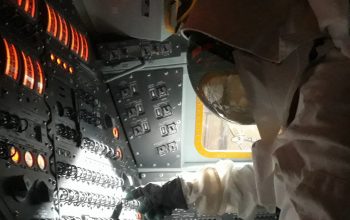Apollo Project Update – Coronavirus Edition
The most recent batch of GoFundMe incentive packages – each consisting of a pre-programmed Arduino Nano with the updated OpenDSKY code, a micro-SD card with audio clips, and an exclusive-edition command reference manual – were shipped yesterday, March 16. With that, all donors who have contributed $60 or more and have provided their shipping addresses have received or will be receiving their updates.
To reduce expenses, incentive packages shipping to domestic addresses have been sent Media Mail. Those going to international addresses require filling out customs forms. In order to do either of these, a physical trip to a Post Office location is required. However, in light of the current situation with the SARS-CoV-2 coronavirus, such trips will be postponed indefinitely. The Apollo Project will continue to accept donations of all sizes, but changes must be made for delivery of incentives.
For donors with domestic addresses (that is, within the USA), there are two options: (1) make the current donation of $60, but expect that delivery will be significantly delayed, or (2) make a donation of $70 or more to cover the additional cost of a shipping method that allows for USPS pickup and eliminates the need for a physical trip to a Post Office location.
For donors with international addresses (outside the USA), the donation amount will still be the same – that is, the $60 plus $24 for international shipping. However, packages will not be shipping for the next few weeks, and after that will be delayed until a sufficient number of packages can be taken to the Post Office in a single trip to reduce exposure, or shipped once the current crisis passes.
At this point, supplies of construction materials have not been affected by the SARS-CoV-2 outbreak, but most of the materials needed for completion of the control panels and much of the interior of the hatch half of the CM have fortunately already been acquired. Work on the Command Module’s control panels and other components continues. Hardboard and MDF for all three Main Display and Control (MDC) panels have all been cut, painted, and are receiving final touches in preparation for assembly. In addition, materials for Panels 4, 5, 6, 7, 8, and 9 are being cut, and acrylic overlays for them are about half completed. Structures for supporting all of these panels are nearly complete, and work is in process on Windows 1, 2, 4, and 5 (actually, the interior of Window 5 is complete). Sconces for cabin lighting have been 3D printed, fitted with COB LEDs, and are working.
Photos and articles documenting this and other progress on the CM will be posted on this site soon. These updates are being delayed in order to focus on construction to meet a deadline for a joint project with a major university (hinted at in other articles and updates). However, various orders and guidelines in response to the SARS-CoV-2 outbreak, both from government and from university officials, have all but guaranteed that this project will be delayed. Such a delay is not definite at this point, so until then work will continue uninterrupted until the deadline is met or the delay is official.
What is “SARS-CoV-2”?
Since nearly all visitors to this site have an interest in science, they will likely also be interested in some facts about the current outbreak. Most media reports and outlets use the phrase “THE coronavirus” to refer to the pathogen causing the latest outbreak. That is a misnomer rooted in misunderstanding and/or misinformation. Misinformation can – and has – resulted in mass confusion and hysteria. Below is some good information that can hopefully ease some peoples’ minds.
A “coronavirus” (abbreviated CoV) is a type of virus that is roughly spherical in shape with numerous projections from the surface, giving it a “corona”. There is a family of coronaviruses consisting of several dozen strains that affect a number of animals. Seven of those strains affect humans, and have been doing so since at least the 1960s (about the same time as the Apollo missions). Four of those strains – HCoV-229E, HCoV-OC43, HCoV-NL63, and HCoV-HKU1 – are widely circulated, and – believe it or not – are responsible for causing about 15% of cases of the common cold!
The first serious human coronavirus outbreak occurred in 2003, and resulted in Severe Acute Respiratory Syndrome, or SARS. The coronavirus strain responsible was therefore given the name “SARS-CoV”. Its ability to cause both upper-respiratory and lower-respiratory infections caused a mortality rate of about 10%.
In 2012, another coronavirus strain emerged in Saudi Arabia with much more serious effects and a mortality rate of about 34%. Because of the location of discovery, the disease was known as Middle East Respiratory Syndrome (MERS), and the virus was named “MERS-CoV”. Other outbreaks of MERS occurred in 2015 and 2016.
The current outbreak started in Wuhan, China, in 2019, and was eventually traced to a new strain of coronavirus (a.k.a. “novel coronavirus” after the Latin word “novus” meaning “new”). After sequencing the virus RNA and classifying it, the virus was renamed “SARS Coronavirus 2” or “SARS-CoV-2” since it appeared to be closely related to the original SARS virus. As demonstrated above, the coronavirus family itself is not new, only this strain is new. Somehow, though, the word “coronavirus” suddenly became the catchword for news media.
The disease caused by SARS-CoV-2 is not being called SARS, but rather “Coronavirus Disease of 2019” or “CoViD-19” (Note: this is the name of the disease, not the virus itself). Unlike its two more serious predecessors, it appears that SARS-CoV-2 has a mortality rate in the neighborhood of 3 to 4 percent. This estimate can’t be refined further because the outbreak is still ongoing, and around half of the reported cases have not yet resolved. While all ages seem equally susceptible to catching SARS-CoV-2, the vast majority of the mortality cases have been in the elderly population, and the least have been in school-age children.
The outbreak itself is serious, not only because of the mortality rate, but also because it appears that SARS-CoV-2 is more contagious than other community-spread viruses. Caution is most definitely warranted to reduce or prevent its spread. However, to put things in perspective, compare the statistics for CoViD-19 to those for this year’s influenza season (numbers at the time of this writing):
CoViD-19 – SARS-CoV-2 strain
– 5,723 cases in the USA; 97 deaths (0 children).
Influenza – A(H1N1)pdm09 and B/Victoria strains
– 36,000,000+ cases in the USA (CDC estimate); 22,000 deaths (144 children).
The CDC’s Weekly Influenza Report is showing a definite downturn in influenza cases over the past few weeks. The extreme precautions being taken for SARS-CoV-2 are likely stemming the spread of flu as well. This is probably a good thing, because even though CoViD-19 doesn’t seem to affect children very seriously, this year’s flu season is one of the most serious on record for young children and young adults and is being compared with the 2009 H1N1 “swine flu” pandemic.
In short, don’t panic, but continue to exercise prudent precautions such as washing hands frequently with soap, covering your coughs and sneezes, avoiding contact with or exposure to those who are ill or show symptoms of being ill, and if you are ill yourself stay home.
Stay safe, stay healthy, and stay interested in science and the Apollo Project!


